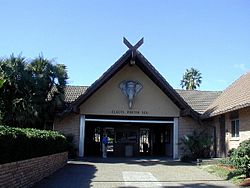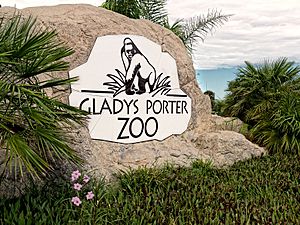Gladys Porter Zoo facts for kids

|
|
| Date opened | 3 September 1971 |
|---|---|
| Location | Brownsville, Texas, USA |
| Land area | 31 acres (13 ha) |
| Coordinates | 25°54′44″N 97°29′46″W / 25.9123°N 97.4962°W |
| No. of animals | 1600 |
| No. of species | 400 |
| Annual visitors | 375,000+ |
| Memberships | AZA |
The Gladys Porter Zoo is a special place in Brownsville, Texas. It's not just a zoo for animals, but also a beautiful botanical park with many plants. The zoo opened on September 3, 1971. Every year, over 375,000 people visit this amazing park.
The zoo covers 31 acres. It is home to about 400 different kinds of animals. This includes 47 endangered species, which are animals at risk of disappearing forever. You can also see over 250 types of tropical plants here. The Gladys Porter Zoo was the first zoo to successfully breed the Jentink's Duiker. This is a type of small antelope that is vulnerable in the wild.
The zoo is named after Gladys Porter. She was the daughter of Earl C. Sams, who used to be the president of J. C. Penney stores. Gladys loved wildlife and helped plan the zoo. The Earl C. Sams Foundation paid for the entire zoo. After it opened, the zoo was given to the city of Brownsville.
Discovering the Zoo's History
The Earl C. Sams Foundation planned, built, and stocked the zoo. Then, they gave it to the City of Brownsville. The zoo first opened its doors on September 3, 1971. The first new exhibit added was the Herpetarium. This building, filled with reptiles and amphibians, opened in April 1973. The zoo has received the most money from the foundation that Earl C. Sams started.
In January 1972, the zoo started publishing its official newsletter, Zoo News. This newsletter is now published four times a year. The zoo's natural-looking exhibits won an award in 1979. It was for outstanding construction in Texas.
Learning and Growing at the Zoo
In 1978, the zoo began its summer study programs. These classes were for kids in grades 1 through 12. Only four classes were taught that first summer. But the program has grown a lot! Now, classes are offered in the spring, fall, and summer. Also in 1978, the zoo became accredited by the Association of Zoos and Aquariums (AZA). This means it meets high standards for animal care and education.
Over the years, the zoo has made many improvements. Orangutan Island was made bigger. The Herpetarium got a new section for water animals. Many other exhibits, the gift shop, offices, and food stands were also updated. Most of these projects were possible because of the zoo's yearly Zoofari fundraisers.
In 1986, the zoo started an endowment fund. This is like a savings account that provides money for the zoo's future. The Earl C. Sams Foundation and the Lightner Sams Foundation helped by matching donations. This means they gave money equal to what others donated. The money from this fund helps the zoo stay great and keep improving.
New Exhibits and Education
The Australian exhibit opened in February 1988. This was the biggest new addition to the zoo since it first opened. The Education department also grew in 1989. A special walk-through bird exhibit, called Zack's Aerie, also opened. Private donations made Zack's Aerie possible.


